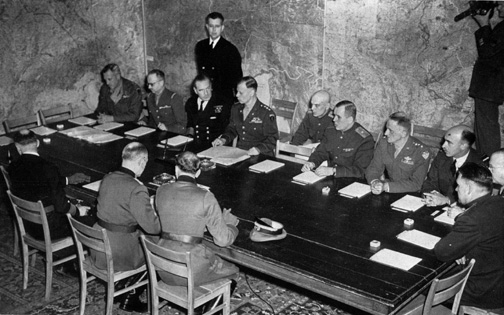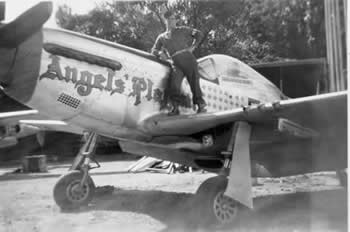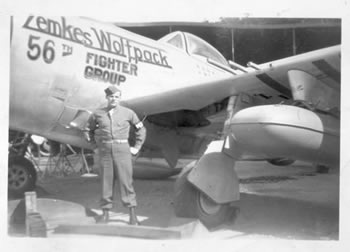|
Chapter 7 — The Gifts of Spring, 1945 The Charles Reed Holden Story by Charles “Reed” Holden of a WW II shoot-down and POW experience as related by a B-17 Ball Gunner: |
||||||
| With the Russian Forces getting close to the prison camp in late April 1945, the Germans asked for a meeting with Col. Zemke for the purpose of turning the camp over to the Allies. The Germans were going to head west to make contact with the British Forces who were getting close to Barth. Col. Zemke agreed with their request and took over the camp. At midnight on May 1st., the Germans left the camp. The camp population became aware of the change in command the next morning when they saw that the American Flag and the Union Jack had replaced the German Swastika flying over the camp. The flags had been hand sewn from scraps of cloth and hidden for some time. Now with the gates open the G.I.’s were allowed out of camp to visit nearby towns. One afternoon a group of us went into town to see what was going on. There were lot of people going by on the road headed for the nearby town. Our military had knocked out any resistance and these people were allowed in the area for 48 hours, no questions asked. I saw a Russian Soldier riding on a buckboard with a beautiful team of horses, with a couple of cases of booze on the seat. They were looting all the buildings in the town. Finally, I said to the gang I was with, “Lets get the hell out of here before something happens and we get into trouble”. We all agreed and headed back to camp. When you can’t speak the language, my feeling was to leave, which we did. Because of the close proximity of the Russian Forces and the sound of their artillery fire, a scouting team of the liberated prisoners who spoke German and Russian were sent out to intercept the forward elements of the Russian Army. The Colonel was not sure they knew the location of the prison camp, so it was of utmost importance that they make contact with them as soon as possible. The original party arrived late on May 1st with a Russian scout, who was taken to the Stalag. His information was that the main force of the Russian Army was near Stralsund, about 20 km. East of Barth. Most of the interactions between the Allies and the Russians were between Col. Zemke and Col. Zhovanaik,who was later joined by his superior, General Boriav. |
||||||
 |
||||||
|
High Command receives Germany’s unconditional surrender. Photo and text ctsy. Life’s Picture History of WW II, Time Inc. 1950 Editor’s Note: Surrender of an absolutely beaten Germany was signed at 2:41 a.m. on May 7, 1945 at General Eisenhower’s headquarters in the technical college at Rheims, France. Fighting in Europe ended the next midnight. The final collapse had begun in the West on April 29: a million demoralized men gave up in Italy, 400,000 in Bavaria, another million in the Hamburg area. On May 4 word reached Eisenhower from Flensburg, where Grand Admiral Doenitz had set up the government authorized in Hitler’s last testament, that Admiral Hans Georg Friedeburg, the new head of the German navy, was on the way to Allied headquarters to negotiate surrender. At first the Germans insisted on surrendering only to the Western Allies. But General Eisenhower sent word that nothing less than unconditional surrender to all the Allies, including the Russians, would be accepted. Finally, at a long wooden table in the bare, map plastered war room of Allied headquarters, the unconditional documents were signed. Then Doenitz’ representative, Colonel General Jodl, was taken into Eisenhower’s office and charged with the responsibility for carrying out the terms. At Russian headquarters in Berlin 45 hours later the ceremonies were repeated. |
||||||
| The Russians wanted the prisoners transported by land to Odessa, a port on the Black Sea, then by ship to the United Kingdom and then on to the United States, but the idea was rejected and further negotiations followed. Much to the disappointment of almost 9,000 liberated POWs, it took almost two weeks to repatriate the prisoners by air. On May 11th, the Allies secured permission to use an airport adjacent to the camp for the evacuation on the 12th and 13th, within a specific time block of hours. A corridor for travel over Russian occupied territory was set up and by then all the POWs had their meager belongings together. The evacuation plan was to first take the hospital cases and the sick, next the British Troops who for the most part had been in captivity longer than any other prisoners, dating back to 1940. The prisoners were marched in barracks groups to the airport to avoid clogging the highway and loading area. The first plane to arrive on the 12th was a B-17 with Gen. William Gross on board, who was the Commander of the 1st. Air Division of the Eight Force. A C-46 followed with Officers of Gen. Eisenhower’s Staff. Two more B-17s arrived with communication equipment and personnel to establish links with the Eighth Force. Later in the afternoon 30 - 40 more B-17s arrived. The floors of B-17s were equipped with wood decking material to provide a level floor, thereby able to accommodate 25 -30 POWs with a few packed into the radio compartment. Early on the morning of the 13th the sick and wounded were evacuated in six C-46s. Dozens of additional C-46s and C-47s joined the B-17s in the evacuation process. The aircraft crept slowly as the men jumped in and piled up in most cases. They were anxious to be on their way home. They had no idea how many groups participated in the evacuation. On the morning of the third day, the 14th, the remaining men were all flown out aboard B-17s. The last prisoner aboard was Col. Zemke and according to Col. Zemke’s records 8487 prisoners had been evacuated. 

Ellsworth R. Brown was an MP in the AAC attached to Zemke's Wolfpack while in England; he served at several bases while there. This is him standing on the wing of Bruce Carr's plane. It shows the "kills" plainly, as well as Carr's name. He served with the 56th FG while in England, traveling on the QE with thousands of troups, and staying until the "Liberation" when he went to Paris. He received the Victory medal and came home on the Queen Mary. He was turned down for service initially as he had a deformed hand; but in 1942 after several tries to sign up, they finally took him in. The return trip to France did not seem to be through a corridor which the Russians had insisted on, instead the pilot took us over several target cities to view the destruction inflicted by the bombers of the Eight Air Force. We then proceeded to an air base at Laon, France and from there we were transported by truck to what appeared to be a troop carrier base near Rheims. From there we flew on a C-46 to Camp Lucky Strike. What a tremendous relief to be back with our own troops. At Camp Lucky Strike we were debriefed, issued new clothing, given a medical checkup and those that were sick received treatment and were put on special diets. Shortly thereafter we were transported to England where I was scheduled to board a ship for home. There was a delay of some sort with the ship and I had to lay over for a week until another ship was available, so I was able to spend the week sightseeing in London while waiting for the second ship. End of Chapter 7 — Go To Chapter 8 Cover Page — Introductions — Table of Contents Chapter — 01 — 02 — 03 — 04 — 05 — 06 — 07 — 08 or Home - Contact Us - Cold War Hist. - 91st SRS Hist. - Stardust 40 Mission Story |
||||||